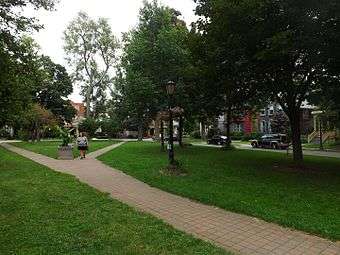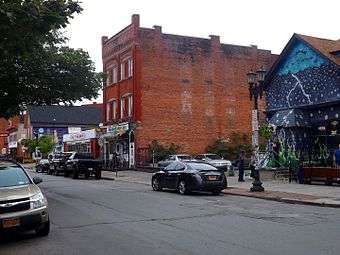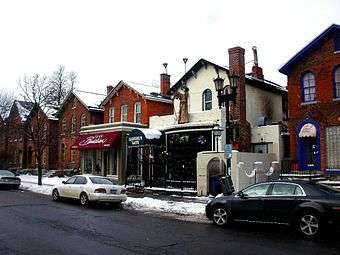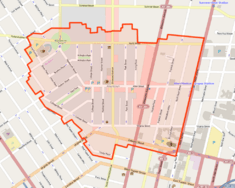Allentown, Buffalo
|
Allentown Historic District | |
|
Buffalo's Allentown district | |
|
Allentown Historic District map (2012) | |
| Location | Buffalo, NY |
|---|---|
| Coordinates | 42°53′58″N 78°52′47″W / 42.89944°N 78.87972°WCoordinates: 42°53′58″N 78°52′47″W / 42.89944°N 78.87972°W |
| Architect | Olmsted,Frederick Law; Et al. |
| Architectural style | Stick/Eastlake, Italianate, Queen Anne |
| NRHP Reference # | 80002605[1] |
| Added to NRHP | April 21, 1980 |
The Allentown district is a neighborhood in Buffalo, New York. The neighborhood is home to the Allentown Historic District.
History
Allentown is named after Lewis F. Allen (1800-1890) who came to Buffalo in April 1827 to serve as Corporate Secretary and Financial Manager of an Insurance company.[2] Allen was also a farmer and when looking for space to let his cattle pasteurize, purportedly his neighbor, Thomas Day, suggested some of his land, which sat between the cities of Buffalo and Black Rock. Allen’s cattle path became known as Allen Street.[3] Notably, Allen was one of the founders of the Buffalo Historical Society and Forest Lawn, where he is buried.[2] Allen was married to Margaret Cleveland Allen and was the uncle of president Grover Cleveland. Allen introduced his nephew to many influential people, including the partners in the law firm of Rogers, Bowen, and Rogers [4] where Cleveland later took a clerkship which led him to practice law and enter into politics.[5]
Geography
Allentown is the first neighborhood north of the Downtown Buffalo core. It borders the downtown theater and entertainment district to its south, and runs north to North Street at its northern edge, Plymouth Avenue on the west, and Main street on the east. The neighborhood is generally centered on Allen Street and Elmwood Avenue.
Allentown is known for its community of artists, for its embrace of bohemian, hipster and gay culture, and for the civic commitment of residents to the historic and aesthetic sensibilities of the neighborhood. Allentown is one of Buffalo's premier areas for nightlife, dining, and antique shopping.
Historic district
The Allentown Historic District is a historic district that was listed on the National Register of Historic Places in 1980,[1] and expanded in 2012. It includes the Kleinhans Music Hall which is separately listed on the NRHP and is further designated as a National Historic Landmark. Also listed on the NRHP is the Birge-Horton House on Delaware Avenue.
The original 1980 boundaries include approximately 733 buildings, not including secondary structures. Of these, 6 are Gothic Revival, 125 Italianate, 24 Second Empire, 92 Shingle style, 106 Queen Anne, 15 Stick, 5 Shingle, 56 Colonial and 196 are plain framed buildings.[6]
Three park areas are included in the area, two redesigned by Frederick Law Olmsted and one circle, Symphony Circle, designed by him as part of his master plan for the city's park areas. After he completed the master plan, Olmsted returned to redesign and landscape Day's Park (named after Allen's neighbor Thomas Day who donated his land to the City of Buffalo[3]) and Arlington Park; two existing city parks. In Day's Park he added a circular walkway in front of the school so the students would not trample the grass. The circular sandstone planting area that was in the center of the walkway is still in existence.[6] Arlington Park was home to Frank Lloyd Wright while he worked in Buffalo.
The new boundaries added about 320 properties to the list.[7][8]
Notable places
- Allendale Theater - home of the Theater of Youth
- Arlington Park - redesigned by Frederick Law Olmsted; home to Frank Lloyd Wright while he worked in Buffalo
- Butler Mansion - currently UB's Jacobs Executive Development Center
- Day's Park - redesigned by Frederick Law Olmsted
- Kleinhans Music Hall - home to the Buffalo Philharmonic Orchestra
- Symphony Circle - Part of the extensive parks and parkways system designed for Buffalo by Frederick Law Olmsted
- Wilcox Mansion - Theodore Roosevelt Inaugural Site
- The Nickel City Housing Cooperative, Buffalo's first single-family housing cooperative, located in Edward Brodhead Green's historic Granger Mansion.
- Trinity Episcopal Church- Noted for its stained glass architecture.
Notable events
See also
- National Register of Historic Places listings in Buffalo, New York
- Neighborhoods of Buffalo, New York
Gallery
-

1913 Allendale Theatre
-

Arlington Park
-

Allen Street bars
-

Tiffts Row
-

Wilcox Mansion
External links
 Allentown and the Delaware District travel guide from Wikivoyage
Allentown and the Delaware District travel guide from Wikivoyage Media related to Allentown, Buffalo at Wikimedia Commons
Media related to Allentown, Buffalo at Wikimedia Commons
References
- 1 2 National Park Service (2009-03-13). "National Register Information System". National Register of Historic Places. National Park Service.
- 1 2 "Lewis Falley Allen". findagrave.com. Retrieved 3 September 2015.
- 1 2 "Neighborhood History". allentown.org. Retrieved 3 September 2015.
- ↑ Nevins, 31–36
- ↑ Graff, 14
- 1 2 "Cultural Resource Information System (CRIS)" (Searchable database). New York State Office of Parks, Recreation and Historic Preservation. Retrieved 2016-07-01. Note: This includes Richard Martin; Darcy Leslie; et al. (August 13, 1979). "National Register of Historic Places Registration Form: Allentown Historic District" (PDF). Retrieved 2016-07-01., Accompanying photographs, and Accompanying captions
- ↑ "Allentown Historic District Expanded". Preservation Buffalo Niagara. Retrieved 22 January 2015.
- ↑ "Cultural Resource Information System (CRIS)" (Searchable database). New York State Office of Parks, Recreation and Historic Preservation. Retrieved 2016-07-01. Note: This includes Francis Kowsky, Martin Wachadlo, Christopher N. Brown, and Daniel McEneny (December 2011). "National Register of Historic Places Registration Form: Allentown Historic District (Boundary Expansion)" (PDF). Retrieved 2016-07-01. and Accompanying photographs
- http://www.allentown.org/
- http://library.buffalo.edu/maps/buffalo-wnymaps/buffalo_neighborhoods.php#allentown
- Graff, Henry F. Grover Cleveland (2002). ISBN 0-8050-6923-2, short biography by scholar



